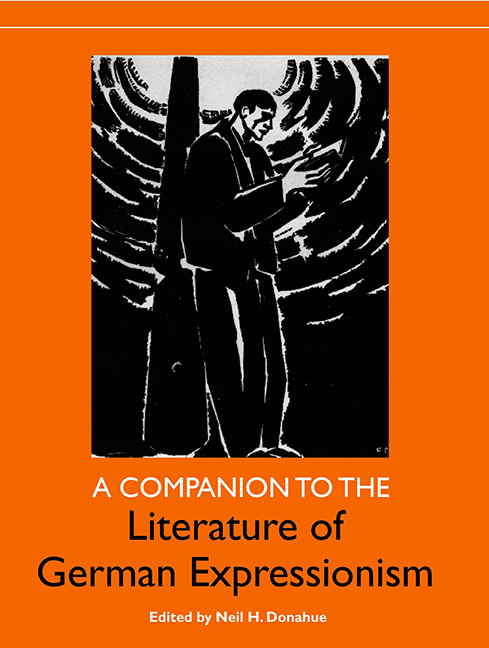Book contents
- Frontmatter
- Contents
- List of Illustrations
- Preface and Acknowledgments
- Chronology
- Introduction
- Philosophical Background
- 1 Metaphysical Mimesis: Nietzsche's Geburt der Tragödie and the Aesthetics of Literary Expressionism
- Prose
- Poetry
- Drama
- Interdisciplinary
- Select Bibliography
- Notes on the Contributors
- Index
1 - Metaphysical Mimesis: Nietzsche's Geburt der Tragödie and the Aesthetics of Literary Expressionism
from Philosophical Background
Published online by Cambridge University Press: 28 April 2017
- Frontmatter
- Contents
- List of Illustrations
- Preface and Acknowledgments
- Chronology
- Introduction
- Philosophical Background
- 1 Metaphysical Mimesis: Nietzsche's Geburt der Tragödie and the Aesthetics of Literary Expressionism
- Prose
- Poetry
- Drama
- Interdisciplinary
- Select Bibliography
- Notes on the Contributors
- Index
Summary
No single thinker had a greater influence on the artists of the Expressionist generation than did Friedrich Nietzsche. Indeed, if one were to mentally subtract Nietzschean ideas and stylistic influences from the intellectual and aesthetic storehouse of Expressionism, what would remain would hardly be recognizable as the artistic and intellectual-historical configuration we know today as literary Expressionism. Will to power; transvaluation of values; a vitalistically defined conception of life; the Zarathustrian Übermensch as the new human being; dithyrambic lyric style; the new pathos; immoralism; eternal recurrence; a scathing critique of the world of the Wilhelminian Bildungsbürgertum (educated bourgeoisie) — for whom Nietzsche, in the first of his Unzeitgemäße Betrachtungen (Unfashionable Observations), coined the derogatory term “Bildungsphilister” (“cultural philistine”; KSA 1:165); and finally, the concept of the Dionysian as a glorified irrationalism and an existential will to embrace the horror of existence: Expressionism would lose all its definition and distinctness if we sought to conceive it apart from these notions indebted to Nietzsche. If we accept the testimony of Gottfried Benn, one of the few great Expressionist writers who lived long enough to look back on the era of Expressionism with historical hindsight, then Nietzsche truly was experienced, in Benn's memorable phrase, as “das größte Ausstrahlungsphänomen der Geistesgeschichte” (that phenomenon in intellectual history with the single most irradiative power; 1048), more influential even than Goethe, the Titan of German classicism. Indeed, Benn goes so far as to remark that everything that interested his generation was already articulated in Nietzsche's works, and that what he and his contemporaries produced was merely exegesis of Nietzsche's seminal ideas (1046). Even if we allow for a modicum of rhetorical overstatement in this remark, we cannot help but come away with the view of Nietzsche as an intellectual giant whom the Expressionists adopted as the flag-bearer of their movement. Indeed, as early as 1918 Eckart von Sydow called Nietzsche the “lodestar” of the Expressionist movement (quoted in Martens, 36). This assertion is confirmed by the formative impact Nietzsche had on the intellectual profiles of most of the leading spokes-people of the Expressionist generation.
- Type
- Chapter
- Information
- A Companion to the Literature of German Expressionism , pp. 39 - 66Publisher: Boydell & BrewerPrint publication year: 2005

